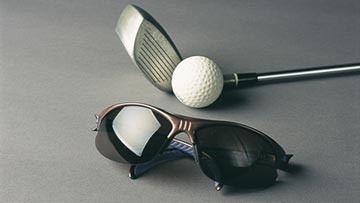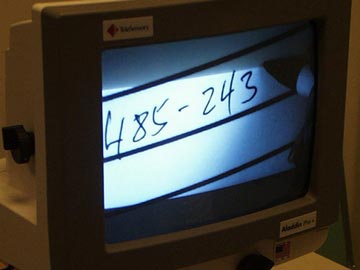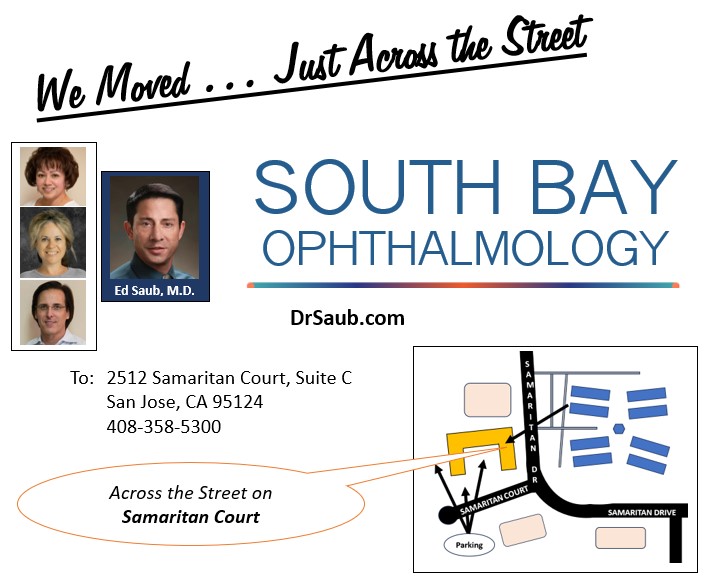Living with Vision Loss

Central vision can be significantly affected with macular degeneration.
From childhood through middle adult life, eye injuries are the leading cause of acquired vision loss.
In later adult life, age-related changes such as glaucoma, diabetes and macular degeneration become the leading cause of blindness.
Once vision is permanently impaired in one eye, preserving vision in your remaining functioning eye becomes extremely important. You must take steps to protect vision in your functioning eye, because loss of vision in that eye will drastically change your lifestyle. Some possible consequences are:
- Reading difficulty
- Loss of job
- Social impairments
- Limited driver’s license
- Loss of recreational abilities
- Legal or total blindness.
 Importance of eye protection
Importance of eye protection
Protection of your functioning eye is very important. At any age, proper eye protection should be worn at all times during work (at your job and at home, especially when mowing the lawn), play, sports or hobbies. Children especially should be taught the importance of protecting their functioning eye and avoiding unnecessary risks. For everyday protection, you should wear impact resistant spectacles with sturdy, non-breakable frames.
Polycarbonate lenses are recommended because they are the strongest and most durable (though still not 100 percent shatterproof). Impact-resistant eyeglasses can be made in many attractive styles. Protective eyewear should be worn for the remainder of your life, even if no prescription is necessary for the correction of vision. Contact lenses alone are inadequate because they do not offer enough protection from injury.
Sports participation
Protective eyewear must always be worn during sports activities. While the risk of eye injuries does vary with the type of sports activity, comparing contact and non-contact sports offers little guidance regarding eye safety. Racquetball, for example, is considered a non-contact sport even though the risk to the eyes is very high.
Participating in sports requires full understanding of the risks involved and the proper eye protection needed. For a young child, parents must participate in making such decisions.
Examples of high-risk sports to avoid are:
- boxing
- wrestling
- full contact martial arts
- sports with high velocity objects (tennis, racquetball, baseball, etc.)
Work and recreation
Many work and recreational activities carry a risk of eye injury. Even simple, everyday items such as pencils or rubber bands can be threats to your eyes. For maximum protection of your vision, always wear protective eyewear. Industrial safety glasses, face shields or even special goggles are necessary for some activities. In addition, proper eyewear and a seatbelt should always be worn while driving in case of an accident. (though still not 100 percent shatterproof). Impact-resistant eyeglasses can be made in many attractive styles.
Protective eyewear should be worn for the remainder of your life, even if no prescription is necessary for the correction of vision. Contact lenses alone are inadequate because they do not offer enough protection from injury.
Maintain a healthy eye
Protection from eye injury is not the only step needed to preserve vision. You should also schedule regular eye examinations with your ophthalmologist (Eye M.D.) to monitor vision and health in your functioning eye. If found and treated early, many eye diseases have little impact on your vision. By taking adequate steps to protect and monitor your vision, you can maintain an active lifestyle.


Low Vision Aids
Various devices are available to assist with vision and daily tasks.
You should discuss these options with your ophthalmologist (Eye M.D.) .
- Anatomy of the Eye
- Botox
- Cataracts
- Diabetes and the Eye
- Diabetic Retinopathy – What is it and how is it detected?
- Treatment for Diabetic Retinopathy
- Non-Proliferative Diabetic Retinopathy (NPDR) – Video
- Proliferative Diabetic Retinopathy (PDR) – Video
- Cystoid Macular Edema
- Vitreous Hemorrhage – Bleeding from diabetes (Video)
- Vitrectomy Surgery for Vitreous Hemorrhage (Video)
- Macular Edema
- Laser Procedures for Macular Edema (Video)
- Laser for Proliferative Diabetic Retinopathy – PDR (Video)
- How the Eye Sees (Video)
- Dilating Eye Drops
- Dry Eyes and Tearing
- Eye Lid Problems
- A Word About Eyelid Problems
- Bells Palsy
- Blepharitis
- Blepharoptosis – Droopy Eyelids (Video)
- Dermatochalasis – excessive upper eyelid skin (Video)
- Ectropion – Sagging Lower Eyelids (Video)
- Entropion – Inward Turning Eyelids (Video)
- How to Apply Warm Compresses
- Ocular Rosacea
- Removing Eyelid Lesions
- Styes and Chalazion
- Twitches or Spasms
- Floaters and Flashes
- Glaucoma
- Selective Laser Trabeculoplasty (SLT) for Glaucoma
- Glaucoma: What is it and how is it detected?
- Optical Coherence Tomography OCT – Retina & Optic Nerve Scan
- Treatment for Glaucoma
- Retinal Nerve Fibers and Glaucoma (Video)
- Open Angle Glaucoma (Video)
- Closed Angle Glaucoma (Video)
- Visual Field Test for Glaucoma
- Glaucoma and Blind Spots (Video)
- Treatment for Glaucoma with Laser Iridotomy (Video)
- Laser Treatment for Glaucoma with ALT and SLT (Video)
- Surgical Treatment for Glaucoma with Trabeculectomy (Video)
- Surgical Treatment of Glaucoma with Seton (Video)
- Keeping Eyes Healthy
- Laser Vision Correction
- Latisse for Eyelashes
- Macular Degeneration
- Macular Degeneration – What is it and how is it detected?
- Treatment for Macular Degeneration
- Dry Macular Degeneration (Video)
- Wet Macular Degeneration (Video)
- Treatment of Macular Degeneration with Supplements
- Treatment of Wet Macular Degeneration with Anti-VEGF Injections
- Amsler Grid – A home test for Macular Degeneration (Video)
- Living with Vision Loss
- How the Eye Works – The Macula (Video)
- Other Eye Conditions
- Central Serous Retinopathy
- Lattice Degeneration of the Retina
- A Word About Other Eye Conditions
- Amblyopia
- Carotid Artery Disease and the Eye
- Fuch’s Corneal Dystrophy
- Herpes Simplex and the Eye
- Herpes Zoster (Shingles) and the Eye
- Ischemic Optic Neuropathy
- Keratoconus
- Macular Hole
- Macular Pucker
- Microvascular Cranial Nerve Palsy
- Migraine and the Eye
- Optic Neuritis
- Pseudotumor Cerebri
- Retinal Vein Occlusion
- Retinitis Pigmentosa
- Retinopathy of Prematurity
- Strabismus
- Thyroid Disorders and the Eye
- Uveitis
- Vitreomacular Adhesions / Vitreomacular Traction Syndrome
- Red Eye
- Refractive Errors
- Retinal Tears and Detachments
Disclaimer
This Patient Education Center is provided for informational and educational purposes only. It is NOT intended to provide, nor should you use it for, instruction on medical diagnosis or treatment, and it does not provide medical advice. The information contained in the Patient Education Center is compiled from a variety of sources. It does NOT cover all medical problems, eye diseases, eye conditions, ailments or treatments.
You should NOT rely on this information to determine a diagnosis or course of treatment. The information should NOT be used in place of an individual consultation, examination, visit or call with your physician or other qualified health care provider. You should never disregard the advice of your physician or other qualified health care provider because of any information you read on this site or any web sites you visit as a result of this site.
Promptly consult your physician or other qualified health provider if you have any health care questions or concerns and before you begin or alter any treatment plan. No doctor-patient relationship is established by your use of this site.


